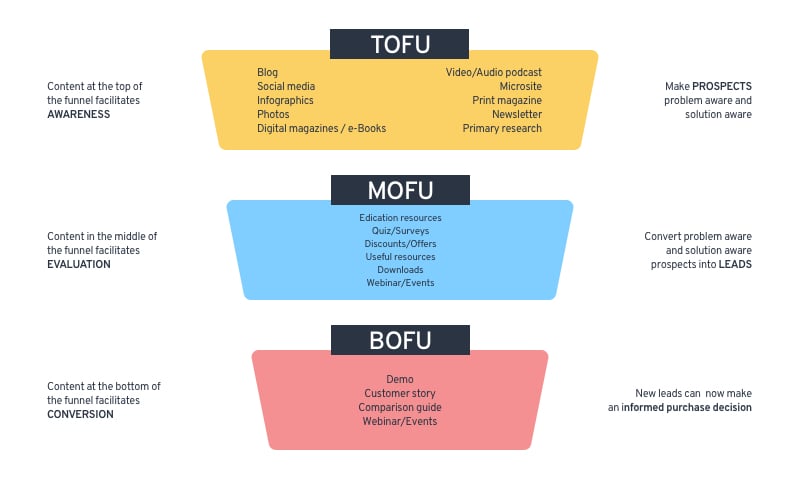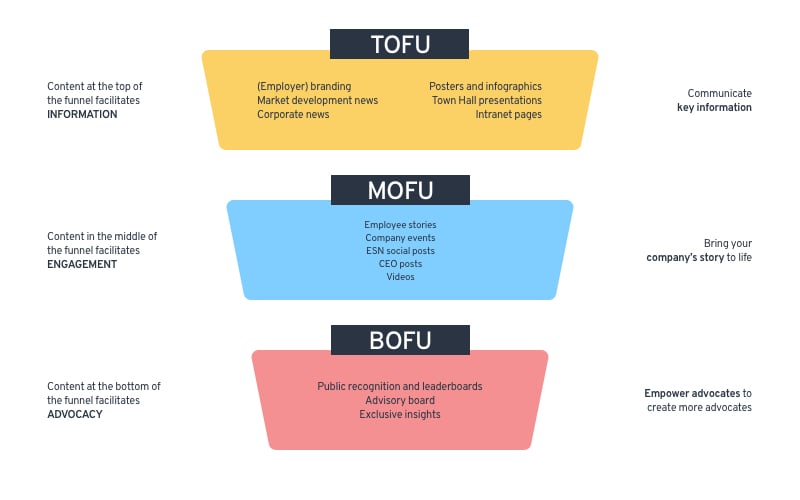
Internal Communications Expert insights
The internal content marketing funnel

5 mins read
Start building your digital home with Happeo
Request a demoInternal Communications Expert insights
Product
Features
Solutions
Happeo for
Use cases
Resources
Explore
Support
Happeo For
Use cases
Comparisons
Explore
Support
Recent

Jonathan Davies
5 mins read
Content marketing and Employee Engagement have more in common than you think. There’s no reason the two disciplines can’t learn from each other. In both cases, storytelling is the method used to engage, invoke and convert an audience.
The difference? Content marketing is done for commercial gain. Internal content is there to increase Employee Engagement, eventually leading to Employee Advocacy. Naturally, what content marketers do and what Internal Communicators and Employee Engagement practitioners do cannot be summed up into a funnel – but the content we generate over a social intranet certainly can.
Content marketers are generally writers – though they’ll also dabble in video and audio content. Think of them as journalists, with one exception. Instead of writing for a newspaper, they write for a company. Activities are spread across a content funnel (more on that ahead), but the largest part of what they do is writing, video editing, podcast hosting and sometimes, graphic design. The skill set is similar, and in the end both disciplines want the same thing – to engage an audience to perform meaningful action. For content marketers that’s usually a purchase or a demo request. For Internal Communicators and Employee Engagement practitioners it varies – it can be anything from a decrease in talent turnover, to an increase in employee happiness or productivity. Luckily, as we discussed before, that still relates to meaningful increases for an organization – well-informed employees will sell better than uninformed employees, to name an example.
A basic content funnel usually looks like this:

Top-funnel content (TOFU) is there to create awareness. This is where the popular term “thought leadership” usually comes in. Middle-funnel content (MOFU) is usually gated behind a sign-up form. The person who fills in the form and hits the sign-up button receives an original, authoritative piece of content in exchange for those contact details. It’s likely how you ended up reading this report. Depending on GDPR options and regulations, the marketing team behind the content can then get in touch with the person who downloaded the piece of gated content – this is mainly done when there is mutual interest. Bottom-funnel content (BOFU) is highly product specific and is meant to be the last thing needed to convince someone to make a purchase.
The end intent is conversion, which results in commercial gain. That’s a different approach than what you would do for Employee Engagement – though as we discussed before, that can still eventually lead to commercial gain. So what would an employee engagement content funnel then look like? We think it would be something like this:

Here, the basic idea is that TOFU content is one-way communication, and largely factual information. It’s important information that needs to be thrown out there, but it’s not what will get people engaged. That’s where the middle comes in. MOFU content is meant to create engagement, because it’s contextualized two-way communication. An exception to this is video, but because videos can pack so much information in such a short-time frame, we still consider it engaging. It’s also more likely to solicit reactions on your social intranet. BOFU content is there to recognize your main contributors, influencers and company ambassadors. Depending on your organization, you could consider giving them access to exclusive insights on your social intranet. You could also award them a position in a special advisory board – a group of people you can call upon for advice before sending out a specific type of (sensitive) communication. Quite the win-win, right?
This list is by no means exhaustive. Depending on your company, you may even consider flipping around some tactics, add new ones or omit some entirely. An example of this are intranet pages: when they just have information on them, they’re very much on the TOFU level. When they incorporate videos and feeds from social Channels, an intranet page is suddenly MOFU. The point behind this approach is that you start looking at your internal marketing mix and realizing where the value of specific mediums truly lays, and what kind of goals you need to achieve. Always keep in mind: at the end of the day, Internal Communications is quite situational and different groups of employees (see the chapter before this) have different needs.
Many content marketers will write top-funnel content in a way that search engines can find it easier. This is called Search Engine Optimization (SEO). Most of the times, top-funnel content ends up being found on Google because it has a large amount of popular key search terms in them. When someone lands, from Google, on the page with top-funnel comment, they will usually get a pop-up or other Call To Action (CTA) to download a gated piece of content – again, it’s an exchange between someone’s contact details, and valuable insight in the form of a whitepaper, webinar or something else. Since the content you write stays within your social intranet, search engines won’t pick up on it. It’s not on the World Wide Web after all. That means you don’t have to stuff your posts with keywords – but there’s still something to learn here.
Language can tell us what the impact of our message truly was. If, for example, a letter from the CEO introduces the term “brand-optimized sales”, and you start seeing the term “brand-optimized sales” across posts and articles in your social intranet, then you have a good idea of how well that message was received. As Mike Klein would say, now you’re measuring Return on Impact, not just Investment.
Remember that vision on the social intranet? The one you developed after reading the first chapter of this whitepaper? I know, I know – here we go again. But now it’s time to bring that vision to life. Using the rest of the chapters in this whitepaper, define key metrics on relevant actions required to reach that ambitious vision. Define how you will spread your time – will you focus 100% on TOFU, and 0% on MOFU and BOFU? Or will you spread it out an even 33%? What about 30% TOFU, 60% MOFU and 10% BOFU?
Decide on an approach, in the form of projects, that’s necessary for you to crush those ambitious goals – the funnel should give you the clarity you need to formulate those projects into actionable language. For example, “Written 15 employee stories” is a great project name. Why? Because the outcome is clearly defined in the title, in past tense. Is it trackable? Yes, because we’re talking about 15 employee stories. Can we relate it to a level in the funnel? Yes, it’s clearly engaging, contextualized content, so it goes in the middle. Does that fit in with your overall strategy? Well, that depends on the amount of MOFU content you need to achieve your goals.
Get it? It’s a lean approach to project management. You don’t reach the top of the mountain with one big jump. It takes many small steps to get there. Your job is to define those small steps, and what the top of the mountain looks like.
